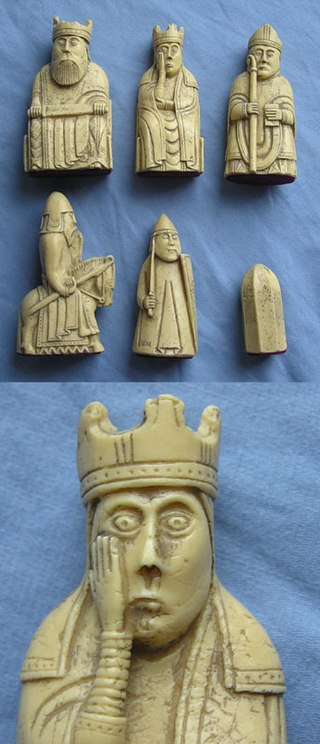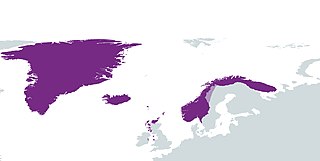This article needs additional citations for verification .(December 2023) |
Magnus (III) Gibbonsson (1256-1273) [1] was an Earl of Caithness and Orkney. He was the son of Gilbert, Earl of Orkney, and grandson of Magnus II, Earl of Orkney. [2]
This article needs additional citations for verification .(December 2023) |
Magnus (III) Gibbonsson (1256-1273) [1] was an Earl of Caithness and Orkney. He was the son of Gilbert, Earl of Orkney, and grandson of Magnus II, Earl of Orkney. [2]
Magnus III was the reason that the disputes between his two overlords, Håkon IV of Norway for Orkney and Alexander III of Scotland for Caithness transformed into open conflict the Scottish-Norwegian War.[ citation needed ]
Scottish provocations against Norwegian vassals in the Hebrides led Håkon IV of Norway to undertake a punitive expedition to reassert his suzerainty under his western island domains. Magnus Gibbonsson was summoned to Bergen and placed at the head of part of the Norwegian fleet which sailed towards Shetland and Orkney in order to strengthen itself. After the Battle of Largs, King Håkon IV of Norway, aged and tired, decided to winter in Orkney where he died in 1263. The Treaty of Perth, signed in 1266, between Scotland and the new King Magnus VI of Norway ended to the conflict and maintained Norwegian suzerainty over Orkney.
The death of Magnus is noted in 1273 by the "Annals of Iceland." He was succeeded by his eldest son Magnus Magnusson. [2]

The Orkneyinga saga is a narrative of the history of the Orkney and Shetland islands and their relationship with other local polities, particularly Norway and Scotland. The saga has "no parallel in the social and literary record of Scotland" and is "the only medieval chronicle to have Orkney as the central place of action". The main focus of the work is the line of jarls who ruled the Earldom of Orkney, which constituted the Norðreyjar or Northern Isles of Orkney and Shetland and there are frequent references to both archipelagoes throughout.

Haakon IV Haakonsson, sometimes called Haakon the Old in contrast to his namesake son, was King of Norway from 1217 to 1263. His reign lasted for 46 years, longer than any Norwegian king since Harald Fairhair. Haakon was born into the troubled civil war era in Norway, but his reign eventually managed to put an end to the internal conflicts. At the start of his reign, during his minority, Earl Skule Bårdsson served as regent. As a king of the Birkebeiner faction, Haakon defeated the uprising of the final Bagler royal pretender, Sigurd Ribbung, in 1227. He put a definitive end to the civil war era when he had Skule Bårdsson killed in 1240, a year after he had himself proclaimed king in opposition to Haakon. Haakon thereafter formally appointed his own son as his co-regent.

Magnus Haakonsson was King of Norway from 1263 to 1280. One of his greatest achievements was the modernisation and nationalisation of the Norwegian law-code, after which he is known as Magnus the Law-mender. He was the first Norwegian monarch known to have used an ordinal number, although originally counting himself as "IV".

Earl of Orkney, historically Jarl of Orkney, is a title of nobility encompassing the archipelagoes of Orkney and Shetland, which comprise the Northern Isles of Scotland. Originally founded by Norse invaders, the status of the rulers of the Northern Isles as Norwegian vassals was formalised in 1195. Although the Old Norse term jarl is etymologically related to "earl", and the jarls were succeeded by earls in the late 15th century, a Norwegian jarl is not the same thing. In the Norse context the distinction between jarls and kings did not become significant until the late 11th century and the early jarls would therefore have had considerable independence of action until that time. The position of Jarl of Orkney was eventually the most senior rank in medieval Norway except for the king himself.

Earl of Caithness is a title that has been created several times in the Peerage of Scotland, and it has a very complex history. Its first grant, in the modern sense as to have been counted in strict lists of peerages, is now generally held to have taken place in favor of Maol Íosa V, Earl of Strathearn, in 1334, although in the true circumstances of 14th century, this presumably was just a recognition of his hereditary right to the ancient earldom/mormaership of Caithness. The next year, however, all of his titles were declared forfeit for treason.

The Treaty of Perth, signed 2 July 1266, ended military conflict between Magnus VI of Norway and Alexander III of Scotland over possession of the Hebrides and the Isle of Man.
Humans have inhabited Orkney, an archipelago in the north of Scotland, for about 8,800 years: Archeological evidence dates from Mesolithic times. Scandinavian clans dominated the area from the 8th century CE, using the islands as a base for further incursions. In the late 14th century the archipelago became part of Scotland.

St Magnus Cathedral dominates the skyline of Kirkwall, the main town of Orkney, a group of islands off the north coast of mainland Scotland. It is the oldest cathedral in Scotland, and the most northerly cathedral in the United Kingdom, a fine example of Romanesque architecture built for the bishops of Orkney when the islands were ruled by the Norse Earls of Orkney. It is owned not by the church, but by the burgh of Kirkwall as a result of an act of King James III of Scotland following Orkney's annexation by the Scottish Crown in 1468. It has its own dungeon.

The Earldom of Orkney was a Norse territory ruled by the earls of Orkney from the ninth century until 1472. It was founded during the Viking Age by Viking raiders and settlers from Scandinavia. In the ninth and tenth centuries it covered the Northern Isles (Norðreyjar) of Orkney and Shetland, as well as Caithness and Sutherland on the mainland. It was a dependent territory of the Kingdom of Norway until 1472, when it was absorbed into the Kingdom of Scotland. Originally, the title of Jarl or Earl of Orkney was heritable.
Thorfinn Sigurdsson, also known as Thorfinn the Mighty, was an 11th-century Jarl of Orkney. He was the youngest of five sons of Jarl Sigurd Hlodvirsson and the only one resulting from Sigurd's marriage to a daughter of Malcolm II of Scotland. He ruled alone as jarl for about a third of the time that he held the title and jointly with one or more of his brothers or with his nephew Rögnvald Brusason for the remainder. Thorfinn married Ingibiorg Finnsdottir, daughter of Finn Arnesson, Jarl of Halland.
Malise V, Earl of Strathearn and Caithness, Jarl of Orkney was the last of the native Gaelic earls of Strathearn.

Clan Sinclair is a Highland Scottish clan which holds the lands of Caithness, the Orkney Islands, and the Lothians. The chiefs of the clan were the Barons of Roslin and later the Earls of Orkney and Earls of Caithness.

Harald Maddadsson was Earl of Orkney and Mormaer of Caithness from 1139 until 1206. He was the son of Matad, Mormaer of Atholl, and Margaret, daughter of Earl Haakon Paulsson of Orkney. Of mixed Norse and Gaelic blood, and a descendant of Scots kings, he was a significant figure in northern Scotland, and played a prominent part in Scottish politics of the twelfth century. The Orkneyinga Saga names him one of the three most powerful Earls of Orkney along with Sigurd Eysteinsson and Thorfinn Sigurdsson.

The Mormaer of Caithness was a vassal title mostly held by members of the Norwegian nobility based in Orkney from the Viking Age until 1350. The mormaerdom was held as fief of Scotland and the title was frequently held by the Norse Earls of Orkney, who were thus a vassal of both the King of Norway and the King of Scots. There is no other example in the history of either Norway or of Scotland in which a dynasty of earls owed their allegiance to two different kings.
Haakon Paulsson was a Norwegian jarl who ruled the earldom of Orkney together with his cousin Magnus Erlendsson from 1105 to 1123. Their lives and times are recounted in the Orkneyinga saga, which was first written down in the early 13th century by an unknown Icelandic author.
Jon Haraldsson was a Norwegian noble who served as the Jarl of Orkney between 1206 and 1231. Jon Haraldsson and his brother David were the sons of Harald Maddadsson with his second wife Hvarflod, daughter of Earl Máel Coluim of Moray. Jon and David were joint Earls of Orkney after the death of their father in 1206. David Haraldsson died of sickness in 1214, leaving Jon Haraldsson to rule alone. William the Lion, king of Scotland, took Jon's daughter hostage in August 1214 as part of a peace agreement with the new sole Earl.
Magnus II was the first in the Angus line of Scottish earls of Orkney. His title was "Earl of Orkney and Caithness."
The Scottish–Norwegian War lasted from 1262 to 1266. The conflict arose because of disagreement over the ownership of the Hebrides. The war consisted of mainly skirmishes and feuds between the kings, and the only major battle was the indecisive Battle of Largs.
The History of Shetland concerns the subarctic archipelago of Shetland in Scotland. The early history of the islands is dominated by the influence of the Vikings. From the 14th century, it was incorporated into the Kingdom of Scotland, and later into the United Kingdom.

The term Norwegian Realm and Old Kingdom of Norway refer to the Kingdom of Norway's peak of power at the 13th century after a long period of civil war before 1240. The kingdom was a loosely unified nation including the territory of modern-day Norway, modern-day Swedish territory of Jämtland, Herjedalen, Ranrike (Bohuslän) and Idre and Särna, as well as Norway's overseas possessions which had been settled by Norwegian seafarers for centuries before being annexed or incorporated into the kingdom as 'tax territories'. To the North, Norway also bordered extensive tax territories on the mainland. Norway, whose expansionism starts from the very foundation of the Kingdom in 872, reached the peak of its power in the years between 1240 and 1319.